Release Notes: Picturepark Content Platform (February 2020 Update)
By Picturepark Communication Team • Feb 14, 2020
Picturepark Content Platform is released in its newest version:
- Version: February Update (10.5)
- Date: 29-February-2020
- Up to the minute release details: https://status-cp-ch01.picturepark.com
- Platform: {name}.picturepark.com
- Main changes:
- Batch Editor: filtering and handling
- Clarifai auto-tagging model support
- Improvements for schema modifications
- Framework upgrades
Release Summary
This release covers 44 different topics, with half of the tasks in feature development & improvements and half of them in bug fixing. This approach ensures the stability and reliability of the Content Platform.
Notable changes include:
- Editors will find an improved Batch Editor, which features: fewer disruptions when changing or working within the single item edit mode, a less cluttered interface, more user-friendly filtering options including a filter toolbar, as seen in the Content Browser, and more.
- Editors can re-use field IDs with the new update mechanism for Content and List Items.
- Admins can now trigger Clarifai Auto-tagging via Business Rules and with support for content updates, specific languages, and different tagging models.
- Performance improvements: Aggregating directly in the search endpoints is now possible, which increases the performance of the system. Additional improvements to collections performance have also been made.
Release Details
Users
Chrome Same-Site Cookies supported
The Content Platform has adapted the authentication method, which is handled by an Identity Server, in order to be compliant with the new Chrome same site cookie handling update and therefore ensures that the login process remains straightforward.
Query String with Search Mode
Users who use the advanced search in Picturepark with the very same criteria on a daily or weekly basis will now be able to save time by bookmarking the result and return directly to it; without re-adding the search criteria.
This will save you time if you need to check for the latest approved product images from your trusted sources in Picturepark each week, or if you have to update the Content Items without a proper title on a regular basis. Simply execute your search, see your result in Picturepark and bookmark the tab in your browser. The query string will have all search criteria available, including the search mode.
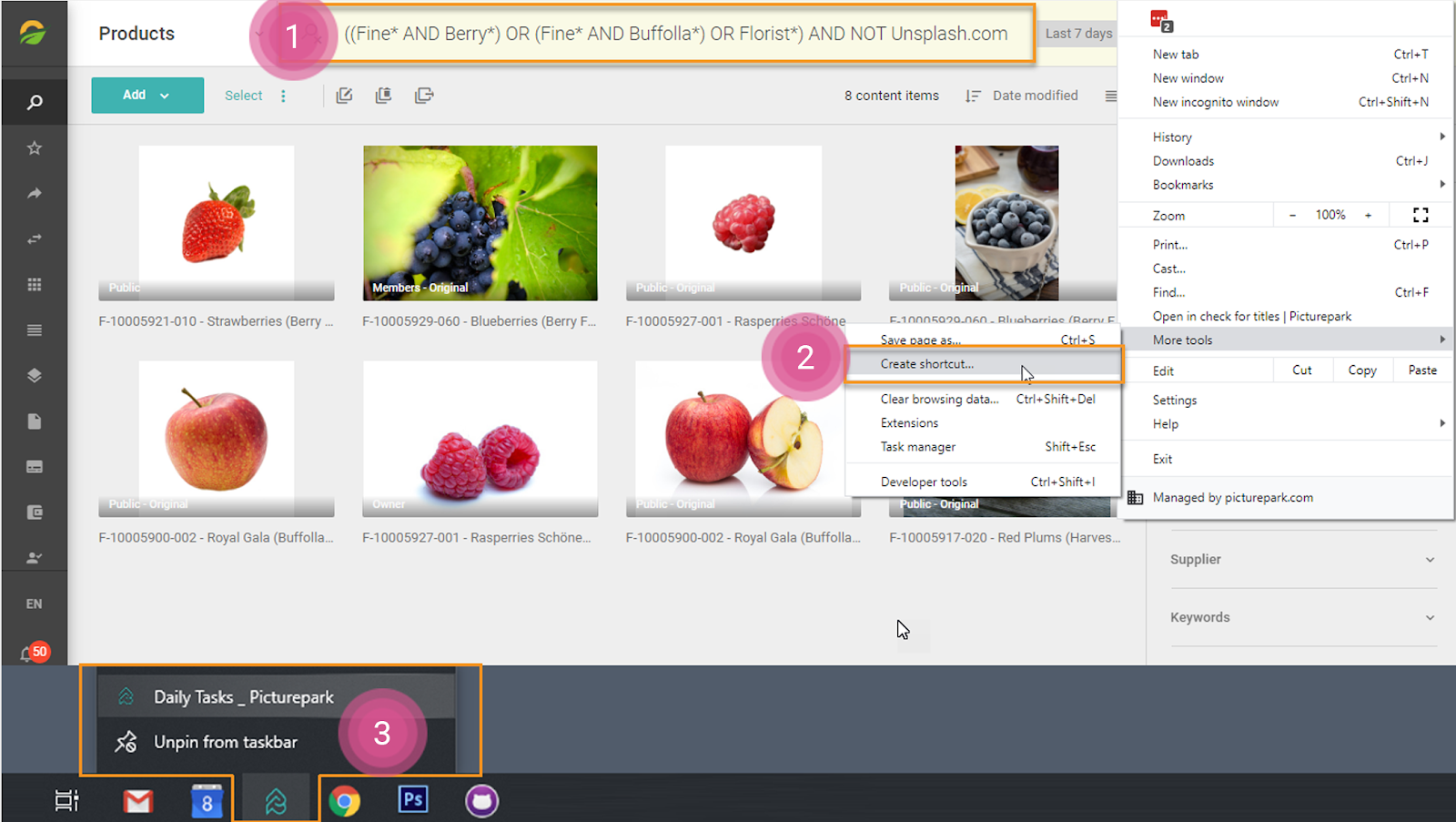
This feature also allows you to copy the URL of a search result - e.g. Content Items with missing copyright information - and then send this link to the colleague who is responsible for copyright updates. You save time explaining your search criteria, as the whole search setup is preserved in the query string.
Bear in mind that the query string is limited to 2000 characters, so please test the URL and the result set before sending or saving it as a bookmark.
Share Limits and Portals
Shares in the Content Platform have a new limit of 1000 items per share. For other use cases, where more than 1000 items are being made available to the public, we recommend using one of our free to use and change microsite samples: the Picturepark Content Portal or the Picturepark Press Portal.
The share also has limited branding options, showing the customer logo at the bottom, whereas the Content Portal supports branding in any way.
Exclusive Permission Set Filter
The Content Platform now enables you to filter for exclusive and non-exclusive Permission Sets concurrently, so you can better drill down and focus on specific content. Those filters are available in the Content Browser, if configured by an admin.
Previously, non-exclusive Permission Sets were removed from filters when an exclusive one was selected, as exclusive Permission Sets overrule all others. For filtering, however, it is helpful to have exclusive and non-exclusive Permission Sets available for selection.
Password Change
You can now change your password directly in the user profile, using a button that opens the corresponding form. Previously, users had to open the Identity Providers and choose the password tab, which led to confusion. After a password change, users must not log in again. The session is updated and saved.
Other Notable Changes
- Virtual items in shares are now correctly displayed in the detail view.
- If you are unsure whether you have already confirmed your registration for Picturepark, just click the confirmation link again and view the new success message in Picturepark, informing you that your registration had already been confirmed. Previously, there was no indication if a user had already confirmed their registration or not.
- Users who work with the same account in multiple Content Platform customers get a message after registration to a new customer (instance) before they are signed up automatically. This way, users can confirm their registration in the new instance, in case it was accidental.
- The sub-menu in the item detail view is now always visible, e.g. for fast navigation to the metadata or permissions sections of the current Content Item. Previously the submenu disappeared when viewed on smaller screens.
- Users will see previews of large documents (e.g. a print-resolution PDF brochure) faster than before, thanks to better data extraction. In a Picturepark test environment, we reduced the runtime of a ~450 page PDF from 2 minutes down to 1 minute. This does not affect the quality or completeness of the full-text search for documents.
Editors
Batch Editor
The filtering behavior for Content Items based on tags and assigned Layers in the Batch Editor is now similar to the filtering style found in the Content Browser. With this change, the icons have also been slightly adapted to clearly indicate the filter criteria. Editors will, for example, find a Layer filter using the Layer icon. Previously the toolbar in the left area of the Batch Editor showed a filter icon, with the only available option to reset.
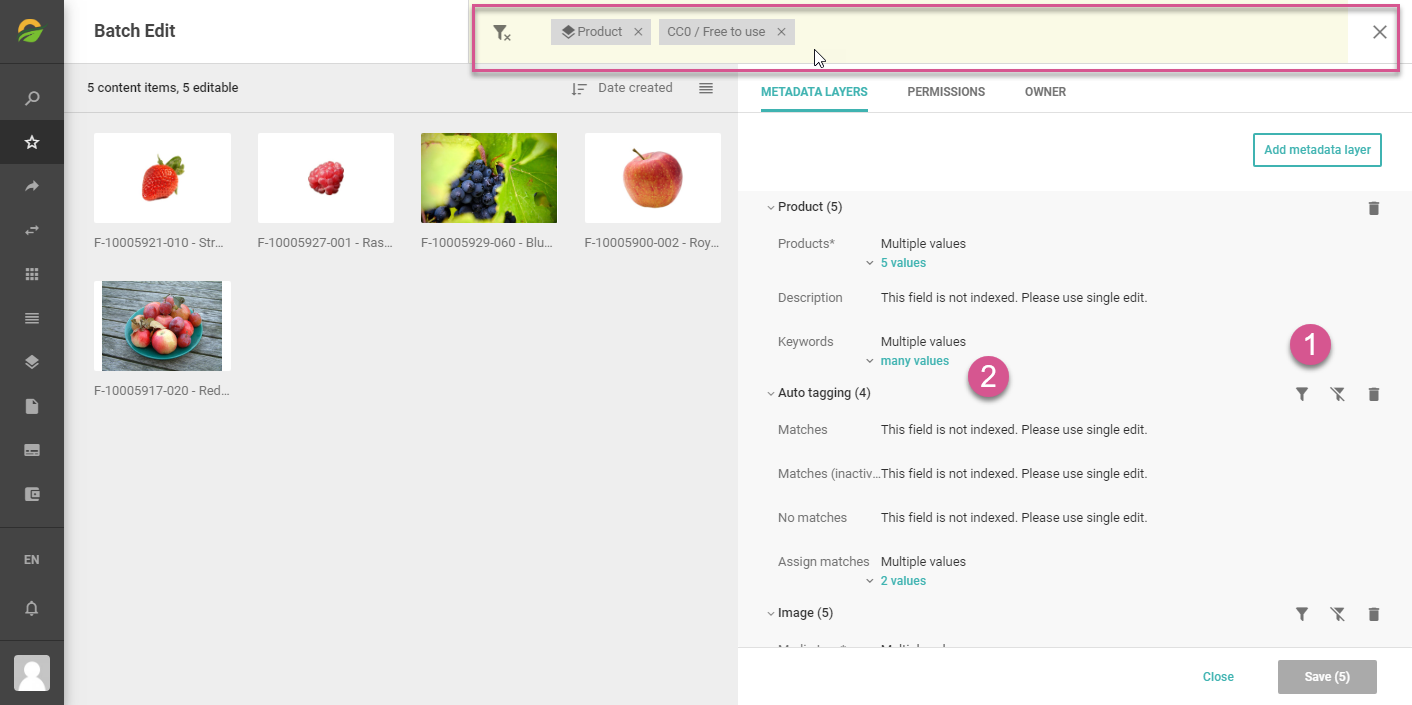
Further optimizations of the Batch Editor have been made in the following areas:
- An undo icon in front of a field reverts changes. Previously, clicking into a field forced the editing user to insert a value or cancel the whole process. Now, editors can revert the action if they accidentally clicked a field that they didn't want to edit.
- For string fields, leaving the field blank while editing removes all values after saving. The remove icon removes the field values too.
- Long string values are displayed better for string fields, which now makes it easier to read the text.
- When working in the batch editor and deleting items, the count is now correct. Previously when saving, the wrong count was shown.
- In the confirmation message, we have slightly optimized the way Layers are displayed, for better readability, by removing unnecessary spaces after the names.
- We renamed the cancel button to close as it just closes the batch editor but does not cancel the edit operation, once it has been started.
- The function “Apply to all” has been removed as this can easily be achieved by using the filters to include or exclude layers and then saving the new entries.
- Fieldsets show the correct display pattern now.
- In the single batch edit mode, it is possible to save Fieldset and Relationship fields again. Be aware that those fields are not editable in batch edit mode.
- The update to Virtual Items is made possible again after editing layers, which are not available for those items.
Translated fields
- The translation component now supports the possibility of updating translations without providing the required default value, if the default value is present. Previously, an editor couldn't just add Spanish, although the default English was available. All language values appear as one line until expanded into a list.
- A new message now informs editors that x out of y items lack the default language value to guide the editor better.
- Editors can empty a translated text field by removing all values in all languages, just as one would expect. Previously, the default language was always required to be filled out; even if the field itself was not required, which made it impossible to clear a translated text field in the Batch Editor.
Performance
- Tagbox fields with lots of tags assigned are displayed with a link “many values” that loads all tags on-demand. Previously, all values were loaded on opening, which slowed down batch editing.
- Another performance improvement is the collapsed view for multiple values, displaying only five values directly, with the option to show more. More values can be loaded in incremental steps of 100 using a “+ next 100” icon. After which, the next 100 values can be loaded and so on. Previously, the field showed all values, which cluttered the Batch Editor edit form.
Permissions
- Editors without 'Manage Permission" can assign Permission Sets again, as they only need 'Edit content' permissions for this kind of action and previously additional permissions were checked.
- Editors will find Permission Sets still listed, even after an exclusive Permission Set was assigned. Previously, all Permission Sets disappeared when an exclusive one became assigned. Now editors can see all assigned Permission Sets in the Batch Editor.
Excel Roundtripping
Editors will now experience some improvements in the Excel Roundtripping App.
- In the List Item Browser, the import button now opens the Excel Roundtripping App when selecting “import” from the toolbar of the List Item Browser or the List Item Detail.
- We completely removed the old import function, so that the Excel Roundtripping App is now in place for all large data exchange operations.
- The search mode selected in the Content Browser (AND, OR, Advanced) is passed correctly to the Excel Roundtripping App. Now, editors can search for multiple terms (any), then choose export and have their items correctly selected in the App; without having to redo the search.
- The selection of List Items is now also correctly passed to the Excel Roundtripping App and Batch Editor. Previously, all List Items were always pre-selected for export.
Admins
User Management
For users that have already been invited, a button to re-invite them is available; which enables Admins to initiate the invitation process again.

A use case for this is when users have lost their invitation in a spam folder, which was then deleted. Previously, admins couldn't quickly invite those who had already been invited, but now, they can start the re-invite upon request multiple times from the User Profile.
Reuse Field IDs after Content and List Item Update
You can now reuse field IDs in Picturepark which previously was not possible; even after the field had been deleted. Using this approach, you can also re-create the field with an updated field type or different settings for single and multi-value fields.
After changing a schema, you will see a badge on Settings in the Main Menu: this leads to the Status page, where you find the new index for Content and List Items. There you can trigger the update of Content and List Items (which are outdated) with the button “update” at the bottom.
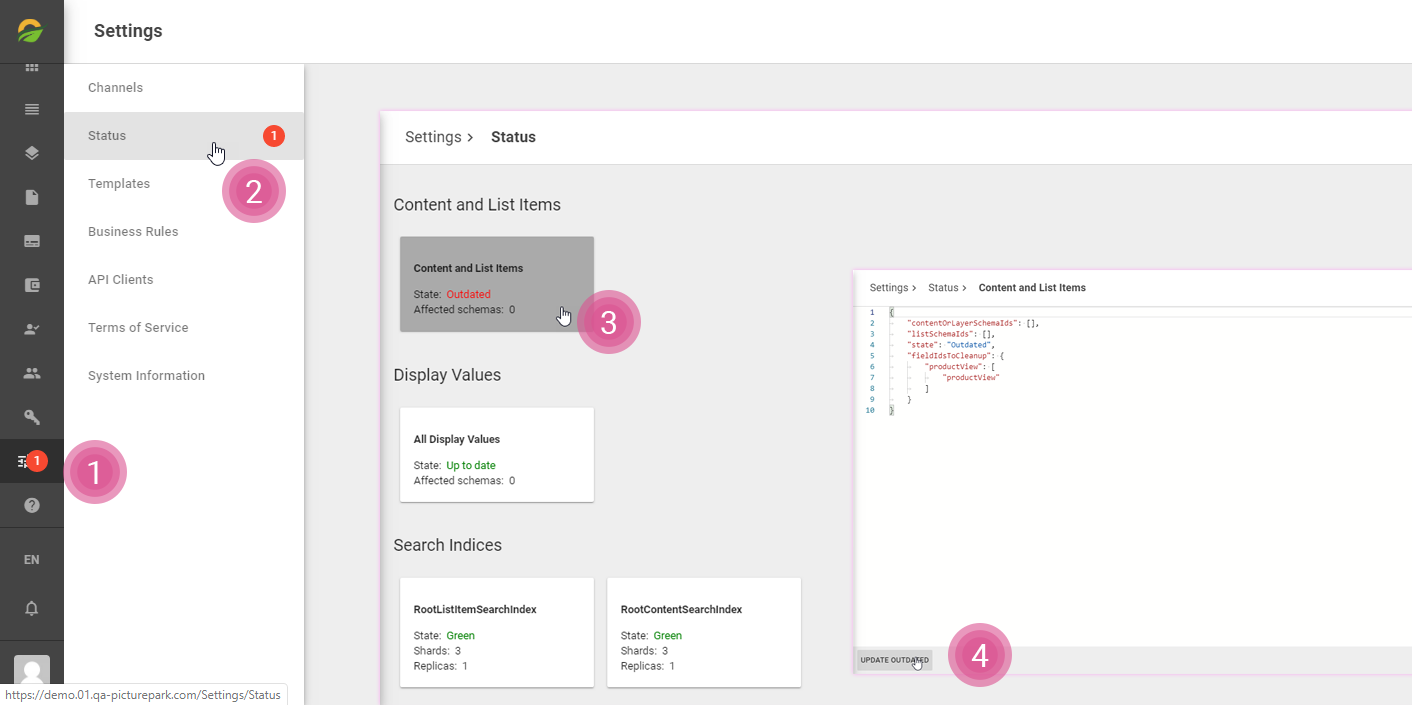
During the update, the user can still modify the schemas (Picturepark does not block additional modifications). Admins can update content while the List Item update is in progress.
This way, the admin can better control when Content and List Items shall be updated, instead of updating all items each time a schema is changed. The significant advantage is to be able to perform multiple changes to multiple schemas, without waiting for an update of all items after each change. However, the drawback is that some Items may contain obsolete information until the update is triggered, this includes:
- The calculated value for a calculated string field that is not up to date (if its template changed in the schema).
- A reference to a Tagbox or a Relation to a Content Item that is no longer in place, e.g. if the editor removed the Tagbox from the Layer and Content Items that had this Layer and multiple tags added.
- The search may find Content Items for tags that are no longer present in their metadata profile.
The update affects Content and List Items of schemas (Lists, Layers, Relationships etc.) that have been directly or indirectly modified because of Fieldset or Relationship fields, as well as schemas modified by other users in the meanwhile. Such updates should be planned to be carried out outside of office hours to reduce the level of inconvenience for users. Do not trigger all updates at once (Content and List Items, Display Pattern, Search Index). The three updates all running concurrently results in long-running operations, and users may experience slow performance. The update shall follow the order of display, so Content and List Items first and Search Index last.
Bear in mind that the removal of a field does not affect the Display Pattern status, so a broken Display Pattern due to missing field values can not be detected at this point.
Clarifai Auto-Tagging
Clarifai auto-tagging can now be triggered as an action for a regular Business Rule, on import and update, featuring model and language selection, among others. Previously, Clarifai was always triggered whenever importing images. This change provides control over which Content Items Clarifai should or should not auto-tag.
Clarifai supports different models, each specialized for different purposes such as: tagging celebrities, demographics, apparel and fashion, travel, or others. A better-suited model increases the number of matches for tags. The models are listed here: https://www.clarifai.com/models. Additionally, a custom model can use Picturepark keyword lists to match company-specific or custom terms. Up until now, Picturepark used the general model for finding tags; as it is the best fit for general purposes, recognizing over 11'000 different concepts, including objects, themes, moods, and more, with outputs in 23 different languages.
Editors can add the tagging model, language code (for tags to use), and match value (confidence value for tag prediction) to a Layer. This means that by assigning the Layer to Content Items, Picturepark Business Rules extract the settings and send the items to Clarifai with the desired configuration. This way, editors can for example easily apply the celebrity layer for tagging or flag content that is deemed as possibly problematic and gets tagged with e.g. “pollution”, “nudity“ or “weapons”.
Please note: customers will need to have and use their own Clarifai account when using Clarifai auto-tagging.
Business Rule Improvements
The Business Rule section has been further improved in the following areas:
- Business Rule JSON edits are now correctly shown in UI form.
- It is not possible to rename a cache used in a Business Rule. Previously, when you renamed a cache then a new one was created: this behavior is disabled now. Please create a new cache from scratch with the correct settings to use in your Business Rule.
- The Assign Tag Action in Business Rules now stores List Item ID’s (refId) in the correct form, which previously had to be checked and changed in the JSON.
- Bugfix in Business Rules to retain the add button after removal of a condition, previously it had been removed.
- The Business Rule MatchRegEx Condition now has the StoreIn field available in the Business Rule form.
- You can use the Assign Value Action to clear the field value, by setting the value to null and “replace” to true.
Other Notable Changes
- Collections: the reworked backend architecture guarantees system stability and increases performance. Moreover, we implemented additional fixes for Collections:
- The Collections from deleted users are now also deleted.
- With this release, it is possible to start an operation (e.g. edit all) which may affect > 100’000 items and have the option to continue at least with 100’000 items. Previously, Picturepark didn’t allow any further actions to be taken and the user had to start all over again with a selection smaller than 100’000 items.
- Picturepark now creates extensive collections faster. Nevertheless, the creation of editing collections with 100'000 items will still take some time.
- The count and previews are updated correctly after the removal of content items.
- Mail templates: When creating email templates, always use the style tags in the body instead of adding CSS to the head section. If you found CSS styles added to the head section of Templates but removed in the mail sent out from CP, then this is caused by your mail client.
- General best practice rule for using CSS in emails is to put it inline into tags, see: https://mailchimp.com/help/css...
- Gmail, for example, strips out the style section in the head tag, but their mobile email client keeps CSS in head tags.
- Find additional hints in the documentation.
- We removed the reset password template, as it is obsolete.
- The deletion of a field must now be confirmed by the admin. Previously, removal happened without any confirmation; which could have potentially led to the accidental deletion of fields.
- Number fields which allow decimal values can be used on schemas for product prices or release versions. You can now set minimum and maximum values using decimals.
- Admins can get notified about system tasks, depending on their roles and permissions:
- Picturepark now sends notifications based on role or permission. This way, notifications can be sent to the correct authorities, e.g. notifications on search index reindexing are sent to those with permission to reindex. In contrast, notifications on display value rendering are essential for user roles with ‘Manage Schema’ permissions. Previously, all system task notifications were sent to all users with an Administrator role.
- Also, Picturepark system admins can define two new options in the customer configuration:
- EnableSupportUserRegistrationEmailNotification -- sends an email to administrators about a registering support user.
- EnableSupportUserRegistrationNotification -- sends a notification to administrators about a registering support user.
- Admins working in the Monaco Editor to update Display Patterns, Business Rules, or Query Filters (JSON Editor) will no longer experience a logout. Previously, editors working in "Monaco Editor" would have been redirected to the login screen after some time, which no longer happens.
- When removing assigned File Types on Layers, Admins will receive a message to inform them about affected Content Items, where the Layer must be removed first. In one of the upcoming releases, Picturepark will take the editors directly to the Batch Editor, where they can clean up affected Content Items.
Developers
For Picturepark integrators some changes are notable:
- A new limit has been introduced for dynamic output retention time, which is a minimum of 1 day and a maximum of 60 days.
- We updated the SDK Samples for our microsites:
- Github now contains a short introduction to both the Content Portal and the Press Portal: https://github.com/Picturepark/Picturepark.SDK.Samples
- There have been some mobile improvements to the Content Portal such as: margins for text, removal of space, display of extracted metadata, show more / show less options in filters, and centering the title. Additionally, the adding to basket functionality has been made more apparent with the use of a Plus icon. When a user shares the items, the share button changes to "in progress."
- The Angular SDK has been improved with CSS declaration cleanups like removal of “!important” and optimizations for the dark theme, like contrast and coloring.
- A new endpoint is available to get the rendered output for a format passed in the request.
The new endpoint /v1/outputformats/preview supports the output format configurations and modifications in the frontend, as admins can get a preview of the output format directly using this endpoint. - The TemplateType is removed from shares in the API, as it is not used anywhere from the API. We planned to support various template galleries for admins to choose from, which is now conceptually changed to the use of Microsites.
- GetMany Operations are now correctly documented with a limit of 100 in the documentation.
API Breaks
ContentMetadataUpdateRequest / ContentMetadataUpdateItem | SchemaFieldsUpdateOptions removed in favor of two options with more granular control over the update behavior: LayerFieldsUpdateOptions - behaves the same as the original SchemaFieldsUpdateOptions, but doesn't affect content, only layers. ContentFieldsUpdateOptions - controls the way in which the content schema of content remains updated, similarly to the original value, Merge means the object in the Content attribute of the update request merges into the existing content. Replace replaces the entire content with the Content attribute. Contrary to the behavior of the first option, if the ContentFieldsUpdateOptions is Replace, the content is replaced even if the Content attribute is null or empty. |
ListItemUpdateRequest / ListItemUpdateItem | ContentFieldsUpdateOptions was introduced, which controls how the content of the List Item is updated. Merge means the object in the Content attribute of the update request merges into the existing content. concurrently, Replace replaces the entire content with the Content attribute. The default value of all the mentioned update options is Merge. |
Share Create, Update, Delete Many | Developers can specify a timeout on endpoints for creating, updating, and deleting multiple shares. |
GetInfo Customer Configuration Endpoint | New attributes baseUrl and logosUrl (Customer Logo) available in customer configuration endpoints. |
OutputFormat Watermark Action | Output formats are documented better. We removed the attribute watermarkText as no backend functionality is available for this setting. |
SearchFilesByTransferIdAsync | SearchFilesByTransferIdAsync is no longer returning FileTransferSearchResult, but directly an IReadOnlyCollection<FileTransfer>. |
UploadOptions | ErrorDelegate on UploadOptions now expects a delegate accepting a (FileLocations, Exception) tuple as an argument. |
Schema, ListItems id | The id property is required. |
User roles, Permission sets, Channels, Output formats, Shares | The name property is required. |
Identity Server URLs updated | Missing and wrong URLs added and fixed. |
Changes to System Limitations
Some limitations have been introduced or changed in order to ensure proper system stability and performance.
- The search query string size is limited to 2000 characters and not updated with additional filters that increase the number of characters. Please test your desired search query string before posting or sending it.
- Collections, which are used for purposes such as editing operations, are limited to 100’000 items. When starting an edit operation for a significantly higher quantity of items, the UI shows a message that the actual selection is too big. Editors can only edit the first 100'000 contents in one operation. The editor can decide if she wants to continue with 100’000 items or cancel the operation. Consider the Excel Roundtripping App for updates to more than 100’000 items.
- Batch Editor displays only 100 layers, permission sets, owners, or virtual items each for editing.
- The creation of a share is limited to a max of 1000 items. For publications larger than 1000 items, use the Picturepark Content Portal microsite.
- Dynamic Output Formats can not be downloaded in bulk but only as a single download. The Dynamic Formats are rendered on-demand and a download of large amounts of files may result in very long waiting times, which are unpleasant for the user.
Known Issues
Here is a list of known issues that users should be aware of when using the Content Platform. If you encounter any other issues than those listed below, then please contact Picturepark Support.
Users
No known issues.
Editors
Batch Editor: Having two filters from one filter group selected in the list item browser and trying to edit the results opens an empty batch editor.
Batch Editor: For list items opened in the Batch Editor, it is not possible to delete list items.
Excel Roundtripping App: No Excel export is possible if a user doesn't have the view right on the referenced lists. If a user doesn't have view rights on any list which is directly referenced in a tagbox field, he won't be able to export the Excel file. The export button is clickable and it leads to the Roundtripping app but there's no selection of fields displayed.
Admins
Edit JSON (Firefox): Scrolling via a mouse wheel does not work in the Settings/Channels Edit JSON form.
Channels: Admins cannot remove missing results from the Display Pattern and go back to default. You can change the missing results from the Display Pattern in a Channel. If you want to change it back to the default one, however, by deleting what you wrote, then it won't let you save because the default language is required to do so.
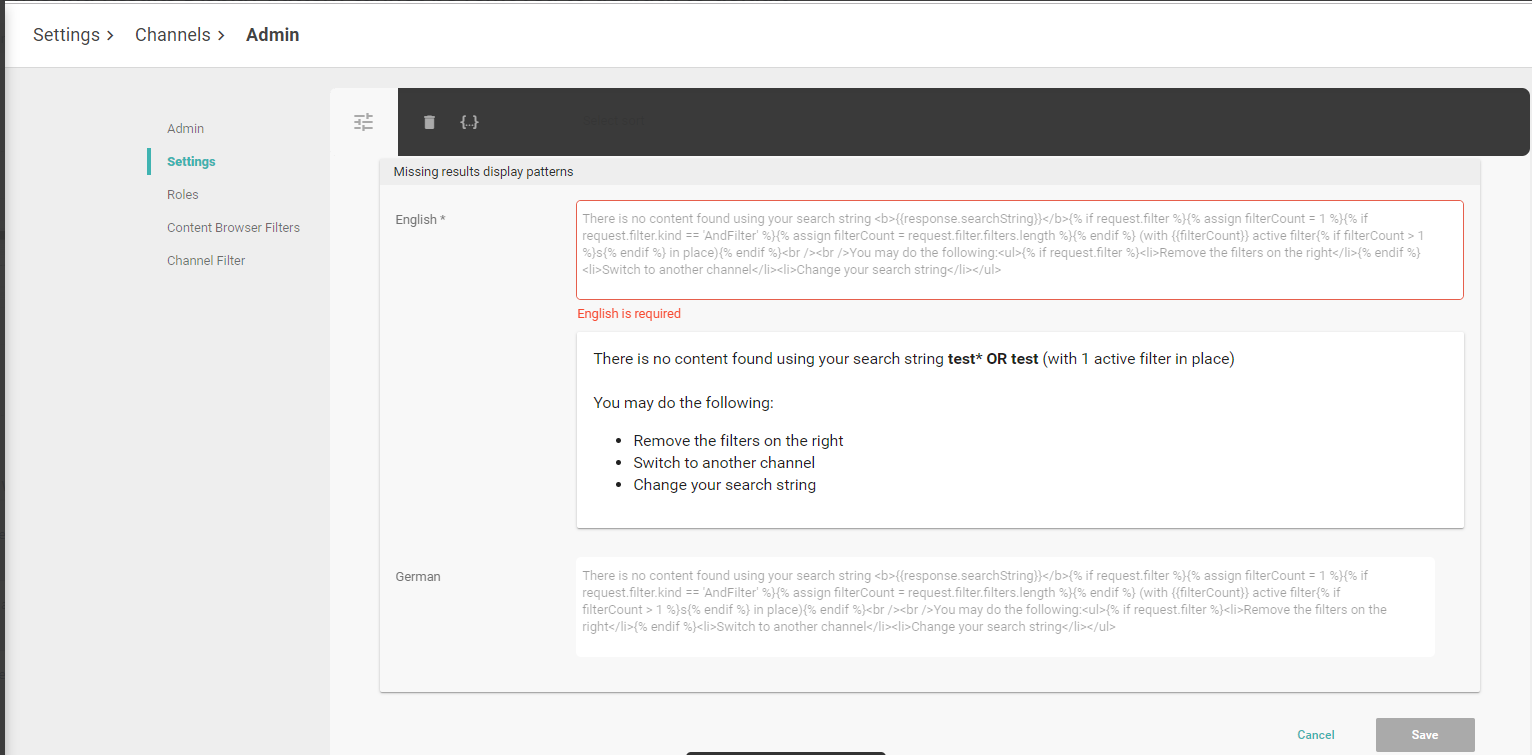
List Items: You can create a list with no fields and then enter an empty list item. You then cannot delete the list item or the list.
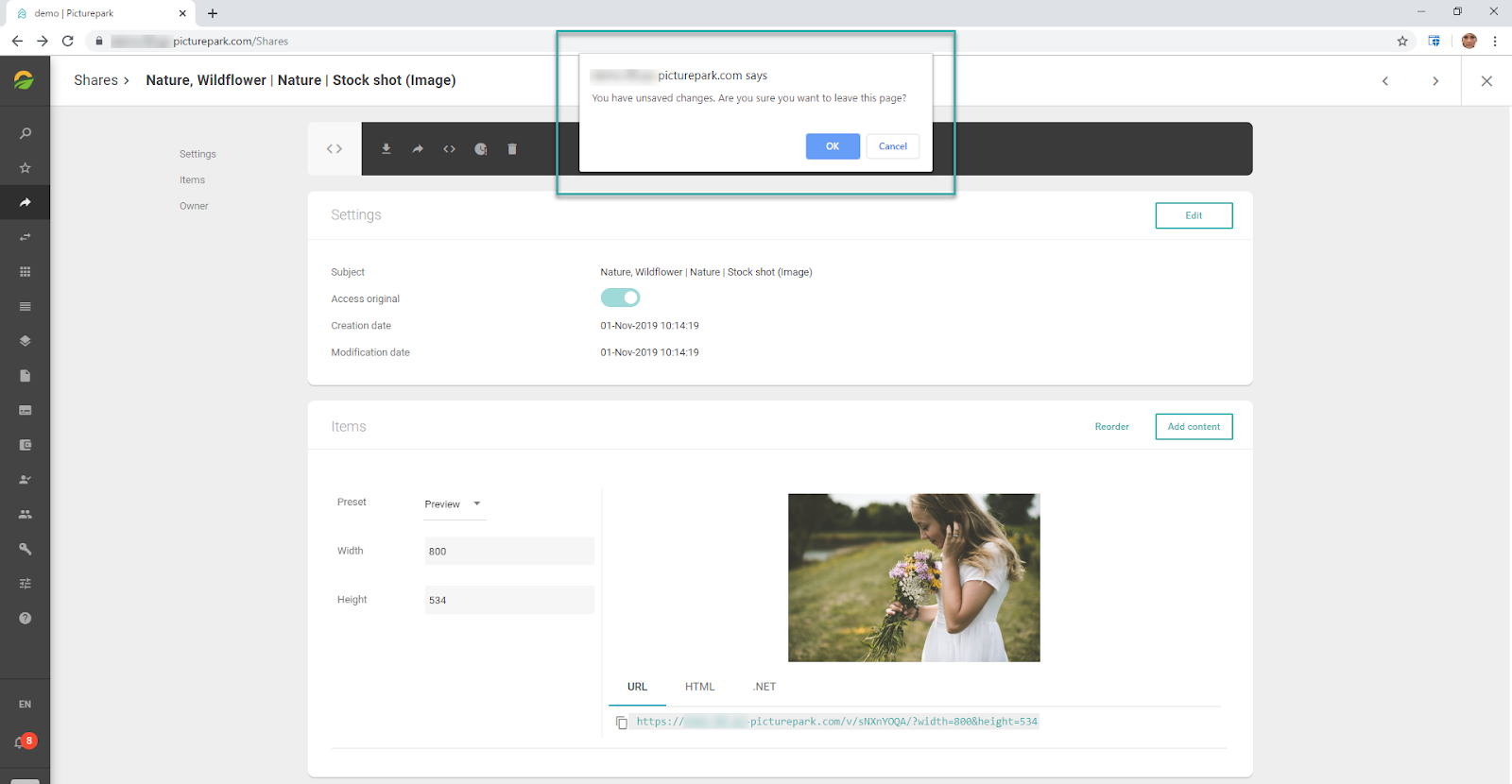
Sneak Peek: The Next Version of the Content Platform
Please find listed below a tentative preview of changes in the next version of the Content Platform, currently planned for release in June 2020 and all subject to be confirmed.
- Support for federated IAM and SSO via Open ID Connect (OIDC): Admins can enable federated single sign-on (SSO) via OIDC with support for ADFS 4.0, Azure AD (and potentially other IDP) for users with role mapping (incl. fall back), and more.
- User Management improvements: Admins can manage users with better user selection, locking/inviting/assigning roles to users in batches, and see additional user information.
- Improve business rule configuration and testing: Admins can configure business rules using new conditions "NOT" and "field empty," better trace errors, and more.
- Improve Angular/Typescript SDK, Microsites: Developers can use a gallery sample for filtering content via the query string, enjoy improved documentation for Angular and Fetch SDKs, and more.
